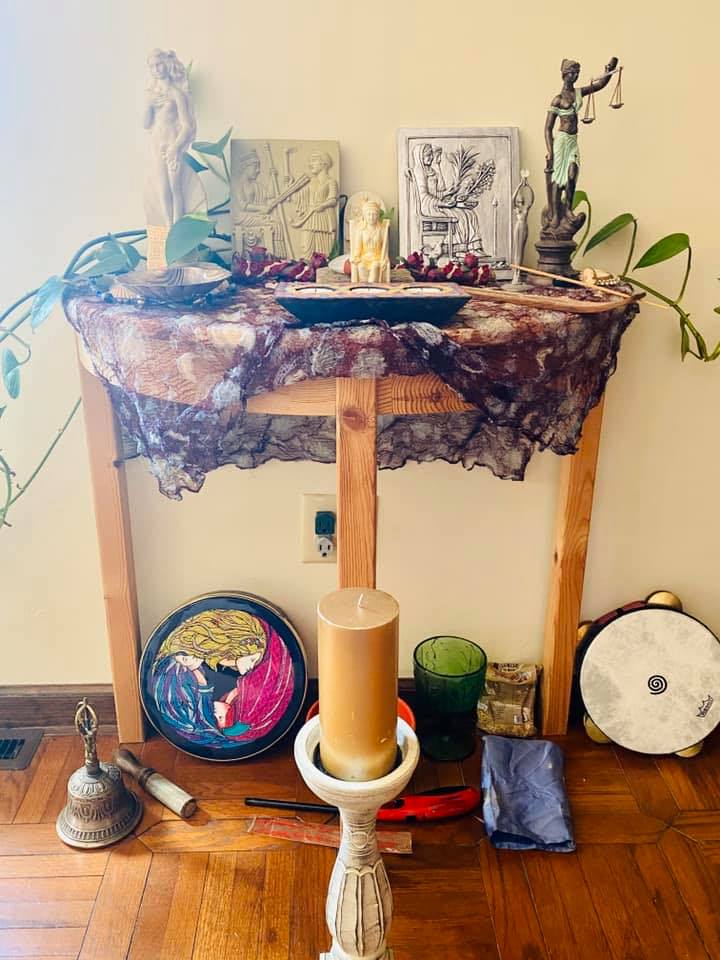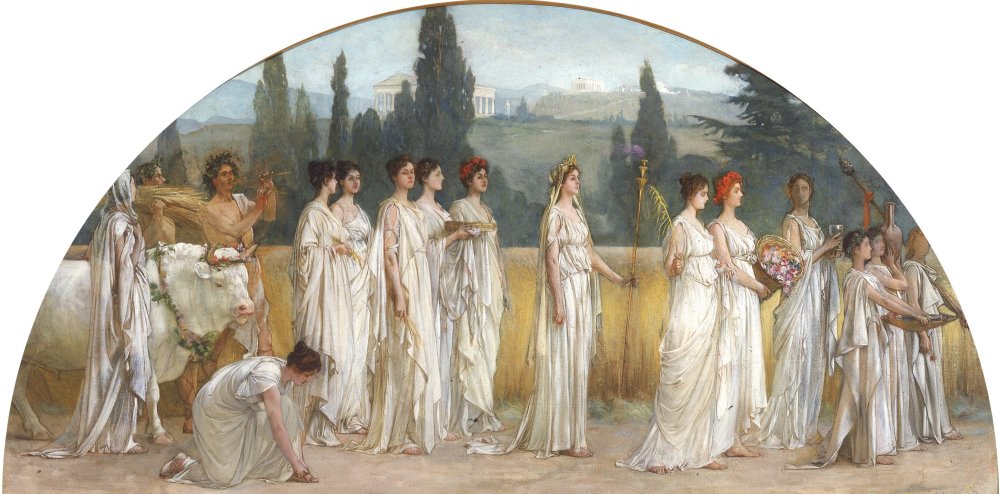One of my vows this year is to celebrate the rituals of the Thesmophoria, an important complex of Eleusinian holidays. As with all ancient holidays, the precise date and number of rituals ranged from region to region, spanning anywhere from three to eleven days around the time of the first sowing or, paradoxically, harvest.
The model I’ve used is from Jennifer Reif’s excellent book Mysteries of Demeter: Rebirth of the Pagan Way, which takes Eleusis as its model. Thesmophoros is an epithet of Demeter, meaning essentially “law-giver” or, perhaps closer in meaning, “carrier of things laid down.” The festival complex was restricted to women.
I go with the interpretation of Thesmophoria as a sowing festival, which is what it would have been in Athens and nearby Eleusis. Here’s the rub: Sowing, in Mediterranean climates, takes place in the winter, as the crops are nourished by winter rains and killed by the summer’s harsh sun. Persephone is enthroned in the Underworld in the summer, the dying time in that particular climate. Celebrating Eleusinian holidays in a colder climate requires practitioners to literally flip the ritual year, since winter is the fallow time here.
Thesmophoria spans a number of days, which is difficult to accommodate in the modern world with its strict work schedules. Therefore, I adopted a practice from the Indian community where I grew up. As the name implies, Navratri — the festival of the Goddess Durga — lasts for nine nights. You can’t pull that off in the West, so the local Indian community celebrates those nine nights on consecutive weekends.
In that spirit, I split Thesmophoria up over consecutive weekends. This also allows me to follow my other path — the Celtic one — on the other weekend day, which is handy when you have a number of sacred commitments. I use both ADF format and Jennifer Reif’s ritual ideas, although not the rituals themselves, which are too group-performance focused for my taste.

Here is the sequence and the general sketch:
- The first rite is Proerosia, held outside. For logistical reasons — the ground was too hard to turn the garden last week — I swapped this with the second rite, Stenia. The pre-plowing rite is held outside, on the perimeter of my garden, and honors Demeter of the fields and Zeus of the rain. In the name of Triptolemus, the first farmer, I will plow three furrows in the soil. Then, I pour a libation of water to Zeus and the sky with the words “Flow forth!” and to Demeter with the words “Give forth!”
- The second rite, Stenia, actually involves sacred vulgarity and profanity. Generally, women get together, crack dirty jokes, get plowed and give each other massages — really. Now, I don’t drink and I’m by myself, so I had to settle for baking cookies and cracking goofy jokes over juice. The deities of the occasion are Melaina, the mourning Demeter, and the demigoddess Baubo, who flashes Demeter and makes her smile. So, flashing the Goddess is an actual sacred act in this rite. Yes, really.
- The third rite, Arkichronia, involves the creation of fertility talismans. Technically, remains of last year’s pig sacrifices were dredged from the offering pit and mixed with the seed, but that’s kind of…. ew. So, I plan to scour my outdoors offering place for any small remnants, mix them with herbs and a snake image in a bag, and bless it for use in the garden. The deity of the occasion is Persephone, still on her underworld throne.
- Thesmophoria proper follows, and I honor both Demeter and Themis, Lady Justice, who is a manifestation of the sacred laws of the earth. I will recite a statement of the laws of Eleusinian practice (at least my laws, since I wrote them) as the main act.
- Just as Reif does, I combine the last two rites, Nestia and Kalligeneia into one rite of Anodos. Nestia means “mourning” and may refer to the mourning Demeter or, in Reif’s interpretation, Persephone’s grief over leaving her husband. Kalligeneia means “beautifully born” and celebrates her return as Kore, the maiden. Anodos simply means “rising.” The deities of the occasion are Demeter and Persephone, obviously. For the Nestia portion, I sound the Tibetan bell and mourn what must remain with the dead. Then, I slap the earth three times (which was done, traditionally, to get the attention of underworld deities) and sing as Persephone rises. Then, I will hang the fertility charm in the garden.
For ADF folks curious about other aspects of the ritual structure: Instead of a bardic deity, I honor Hestia both first and last (that means before the Earth Mother), to follow the reference in the Homeric hymn. I honor Gaea as Earth Mother and Hecate as the Gatekeeper. This makes for a very female-centric rite, but that is the point, ultimately. Eleusinian ritual is very female in nature.
Does that mean men or the genderqueer are unwelcome in modern Eleusinian rites? Of course not. We don’t have the strict separation of gender roles as they did in ancient times. Rather than gender, I see the Eleusinian rites as being centered on role: as nurturer, tender and cultivator. It’s very much the antithesis of “warrior religion,” which makes it an interesting counterpart to my Celtic practice — and also may be why I have been called to bring it back to the world, or at least my backyard.
We may want warrior religion, but perhaps Eleusis is what we truly need.
